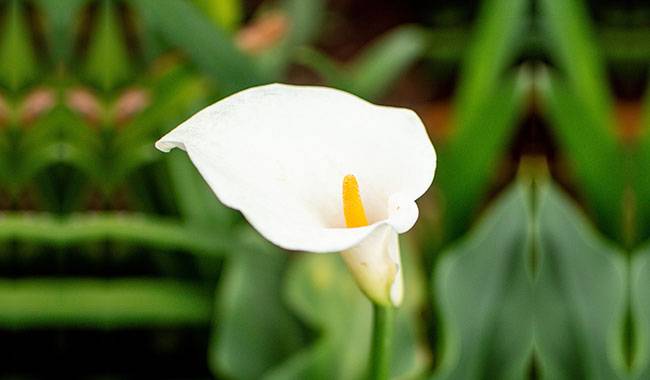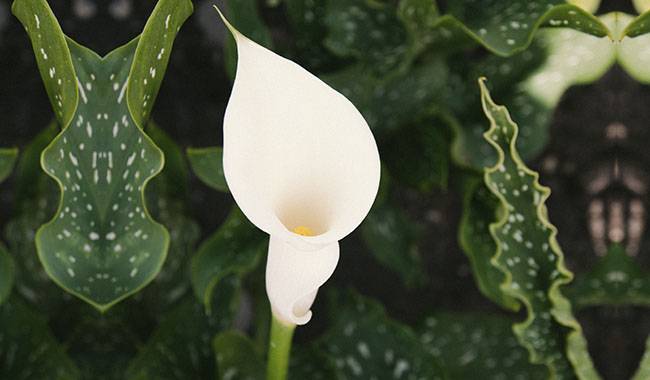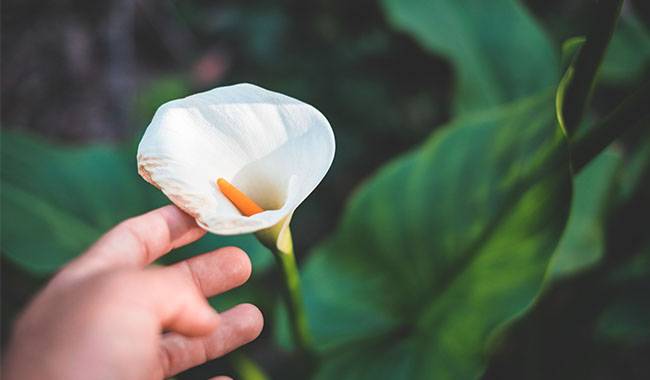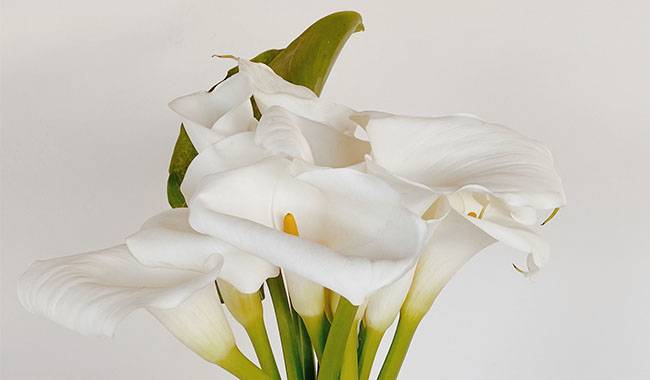
Calla lilies are a beautiful plant to grow either outdoors or indoors in decorative pots next to a sunny window. This elegant plant is native to the swamps of South Africa and is not a lily at all, but a member of the Tenebrionaceae family.
So how to care for a calla lily plant? Calla lilies have funnel-shaped or trumpet-shaped wax-like flowers that grow on tall stems with yellow stalks emerging from the center.
The plant’s cone-shaped, long green leaves may have faint white or yellow spots. Today, thanks to the many new hybrids developed by breeders around the world, calla lilies can be found not only in white, but also in pink, orange, fuchsia, red, yellow, and cream.
The long-lasting flowers are popular in wedding bouquets, where they symbolize purity and beauty.
CALLA LILY CARE
Calla lilies are easy to grow outdoors, growing in zones 8 to 10. They grow from rhizomes, not from bulbs like Asian or Oriental lilies, and another key indicator that they are not true lilies. They will die off in the summer and regrow each year.
To prevent overcrowding, separate the rhizomes every few years. If you live in colder zones 3 to 7, grow calla lilies as annuals. You can dig up the rhizomes and overwinter them in these colder zones, but the results are often inconsistent. Most gardeners in temperate zones purchase new rhizomes each growing season.
Light
As a tropical plant, calla lilies can grow in partial shade in areas with hot, humid summer weather. Some dappled sunlight or bright indirect light is fine, but direct sunlight is too strong for the tender petals.
Soil
Fertile, moist, well-drained soil is the best choice for keeping Calla lilies in bloom. Calla lilies grow well around ponds and can happily tolerate wet or even soggy conditions.
Fertilizer
When the plants are in flower, give indoor calla lilies a low-nitrogen liquid plant food every two weeks. When the plant is producing only leaves and no flowers, fertilize monthly. Always dilute the plant food to the recommended concentration of ½. If your calla lilies are grown outdoors, use granular plant food instead of liquid fertilizer.
Watering
Do not water too much, especially at the initial planting. Once the rhizomes are established, water once a week if necessary. During droughts, make sure the plants are watered.
Temperature and humidity
The room temperature should be between 50°-75°F (10°-24°C) for optimal growth. Calla lilies prefer a fairly warm environment. A summer day temperature of 80°F (26.6°C) is perfect for them.
They also like humidity and moisture, so a humid summer makes for good blooms. If the temperature falls well below 50°F (10°C), the plants will tend to go dormant. If you want to dig up your rhizomes to overwinter, do it before the fall temperatures in your area fall below freezing.
Pests
Check Calla lilies frequently for signs of scale or aphids.
Diseases
Calla lilies are susceptible to various viral and bacterial infections, especially root rot and grey mold. These problems become apparent when the leaves and stems begin to turn yellow before the plant normally goes dormant.
Winter Protection
Clean them indoors before the threat of frost arrives in autumn or early winter so that they can rest after the tubers have given birth.
If planting calla lilies directly in the bed, dig up the tubers from the garden or store them in pots in a dry 55ºF (12.7°C) environment, keeping them in water for eight weeks or more before restarting the cycle with light and water.
USEFUL INFORMATION ABOUT CALLA LILIES

Flowering time
The flowers of Calla lilies really resemble the flowers of the peace lily but are impressive. The plant usually blooms for about six weeks in late spring and early summer. Keeping the plant’s root system growing will encourage more flowers. Calla lilies may be forced to bloom indoors at any time. The long-lasting cut flowers are perfect for bouquets and arrangements.
Companion Plants
Plant plants with dahlias and tangos to make a cutting garden until frost.
Dormancy time
The bulb plant Calla lily is dormant once a year. After the plant blooms, the leaves turn yellow then brown.
Once this happens, prune the plant to soil level and place it in a cool, dark area at a temperature above freezing but no more than 50°F (10°C) for 2-3 months.
Keep the soil very dry and water a little every few weeks to prevent the bulbs from drying out. The area where the plants are stored should be kept at low humidity or the bulbs will mold and deteriorate.
After two or three months, return your calla lilies to a warm place and start watering. Once the green leaves have developed, feed at 1/2 the recommended strength Bulb-specific fertilizer to encourage new growth. The plant should start flowering again within 6-8 weeks.
IS CALLA LILY POISONOUS?
Calla lily is a highly toxic houseplant with a toxicity rating of #3. Please keep away from children and pets.
The plant contains high levels of calcium oxalate, which can cause severe burns and swelling of the mouth, throat, lips, and tongue if ingested. Stomach upset and diarrhea may also occur.
WHY GROW CALLA LILIES?
Gardeners grow calla lilies in garden beds and containers for the following reasons.
- Calla lilies are easy to grow
- They offer a sensual range of colors
- Calla lilies bloom only eight weeks after sowing
- Their arrow-shaped leaves are attractive
- They make attractive cut flowers
TIPS
In warm climates where calla lilies are hardy (zones 8-10), the rhizomes can remain underground and bloom again the following summer. It may be necessary to divide the plant every few years to keep it in good flowering condition.
In cooler areas (zones 3-7), calla lilies are usually considered annuals and new bulbs are planted each spring. Bulbs may be dug up and overwintered indoors, but you may not get the same results the following year.
To try to save your calla lilies for next year, do the following Fertilize the plant throughout the growing season. Cut off the flower stalks as soon as the flowers disappear. Preventing the plant from setting seeds will help save energy for next year’s flowers. Continue fertilizing until the leaves begin to turn yellow.
When the leaves wilt or after the first frost, dig up the rhizomes and trim the leaves, leaving one to two inches of stem. Allow the rhizomes to cure in a warm, dry place for several days, then place them in a box with little to no moist peat moss.
Store the box in a dark place at 50-60°F (10-15.5°C). Check once or twice during the winter to make sure the rhizomes are not too wet (rotting) or too dry (wrinkled). Replant in the spring.





